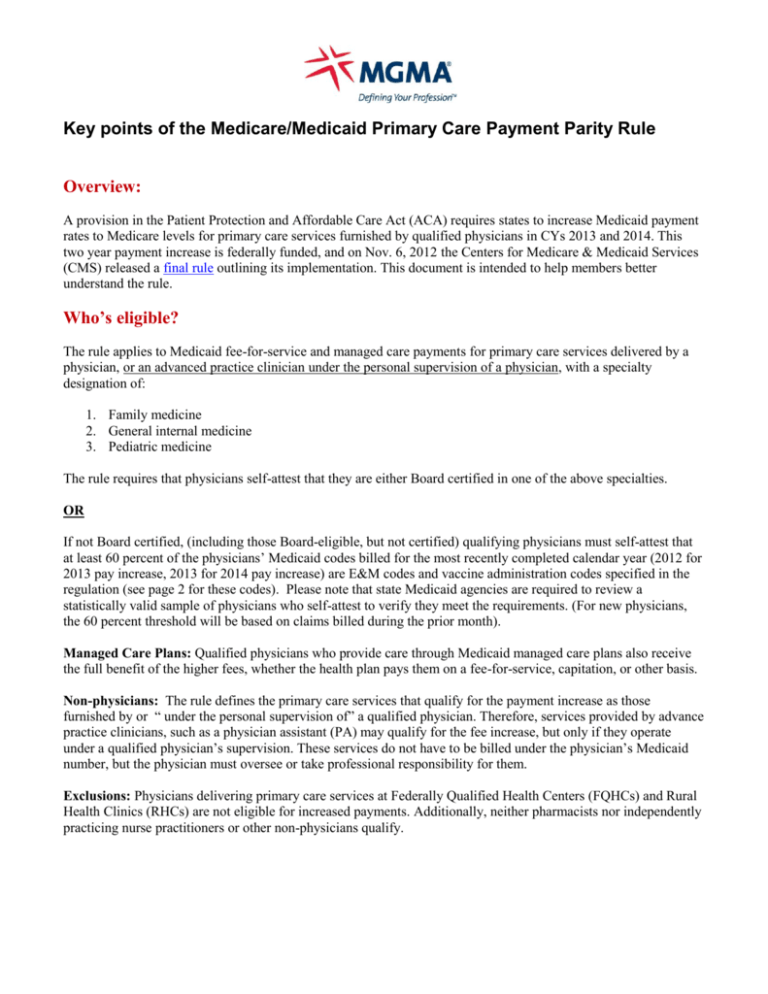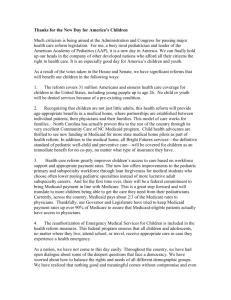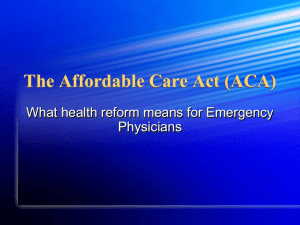Key points of the Medicare/Medicaid Primary Care Payment Parity
advertisement

Key points of the Medicare/Medicaid Primary Care Payment Parity Rule Overview: A provision in the Patient Protection and Affordable Care Act (ACA) requires states to increase Medicaid payment rates to Medicare levels for primary care services furnished by qualified physicians in CYs 2013 and 2014. This two year payment increase is federally funded, and on Nov. 6, 2012 the Centers for Medicare & Medicaid Services (CMS) released a final rule outlining its implementation. This document is intended to help members better understand the rule. Who’s eligible? The rule applies to Medicaid fee-for-service and managed care payments for primary care services delivered by a physician, or an advanced practice clinician under the personal supervision of a physician, with a specialty designation of: 1. Family medicine 2. General internal medicine 3. Pediatric medicine The rule requires that physicians self-attest that they are either Board certified in one of the above specialties. OR If not Board certified, (including those Board-eligible, but not certified) qualifying physicians must self-attest that at least 60 percent of the physicians’ Medicaid codes billed for the most recently completed calendar year (2012 for 2013 pay increase, 2013 for 2014 pay increase) are E&M codes and vaccine administration codes specified in the regulation (see page 2 for these codes). Please note that state Medicaid agencies are required to review a statistically valid sample of physicians who self-attest to verify they meet the requirements. (For new physicians, the 60 percent threshold will be based on claims billed during the prior month). Managed Care Plans: Qualified physicians who provide care through Medicaid managed care plans also receive the full benefit of the higher fees, whether the health plan pays them on a fee-for-service, capitation, or other basis. Non-physicians: The rule defines the primary care services that qualify for the payment increase as those furnished by or “ under the personal supervision of” a qualified physician. Therefore, services provided by advance practice clinicians, such as a physician assistant (PA) may qualify for the fee increase, but only if they operate under a qualified physician’s supervision. These services do not have to be billed under the physician’s Medicaid number, but the physician must oversee or take professional responsibility for them. Exclusions: Physicians delivering primary care services at Federally Qualified Health Centers (FQHCs) and Rural Health Clinics (RHCs) are not eligible for increased payments. Additionally, neither pharmacists nor independently practicing nurse practitioners or other non-physicians qualify. 2 What about subspecialists? This rule also provides for higher payment for related subspecialties as recognized by the American Board of Medical Specialties (ABMS), American Osteopathic Association (AOA) and the American Board of Physician Specialties (ABPS). Lists of specialists and subspecialists can be found on their websites, and are listed below: Family subspecialties: Adolescent Medicine Geriatric Medicine Hospice and Palliative Medicine Sleep Medicine Sports Medicine Addiction Medicine Adolescent/Young Adult Medicine Geriatric Medicine Sports Medicine Undersea and Hyperbaric Medicine Hospice and Palliative Medicine Sleep Medicine Internal subspecialties: Adolescent Medicine Advanced Heart Failure and Transplant Cardiology Cardiovascular Disease Clinical Cardiac Electrophysiology Critical Care Medicine Endocrinology, Diabetes and Metabolism Gastroenterology Geriatric Medicine Hematology Hospice and Palliative Medicine Infectious Disease Interventional Cardiology Medical Oncology Nephrology Oncology Pulmonary Disease Rheumatology Sleep Medicine Sports Medicine Transplant Hepatology Pediatric subspecialties: Adolescent Medicine Child Abuse Pediatrics Developmental-Behavioral Pediatrics Hospice and Palliative Medicine Medical Toxicology Neonatal-Perinatal Medicine Neurodevelopmental Disabilities Pediatric Allergy/Immunology Pediatric Cardiology Pediatric Critical Care Medicine Pediatric Emergency Medicine Pediatric Endocrinology Pediatric Gastroenterology Pediatric HematologyOncology Pediatric Infectious Diseases Pediatric Nephrology Pediatric Pulmonology Pediatric Rheumatology Pediatric Transplant What primary care services are eligible for higher payment? E&M codes 99201 through 99499 and CPT vaccine administration codes 90460, 90461, 90471, 90472, 90473, and 90474 or their successors are eligible. The rule also provides higher payment for the following E&M codes that are not reimbursed by Medicare: Patient/Initial Comprehensive Preventive Medicine--codes 99381 through 99387; Established Patient/Periodic Comprehensive Preventive Medicine--codes 99391 through 99397; Counseling Risk Factor Reduction and Behavior Change Intervention--codes 99401 through 99404, 99408, 99409, 99411, 99412, 99420 and 99429; E&M/Non Face-to-Face Physician Service--codes 99441 through 99444. 3 How does a physician self-attest? Physicians are required to self-attest that they are eligible for the increased payment to their state Medicaid program. The process for self-attesting is determined by state Medicaid agencies and qualified physicians should contact their state Medicaid agency for further information on this process. When can I expect payment? CMS stated in the final rule that to ensure physicians receive the benefit of higher payments in a timely manner, “payments should be made no less frequently than quarterly.” States can, for example, make higher Medicaid payments as add-ons to their existing rates, or as lump-sum payments. For more clarification on payment, please contact your state Medicaid agency as they will be the best resource for additional inquiries regarding payment. What are some other payment factors? For the purposes of calculating the payment, the state must exclude incentive, bonus and performancebased payments but must include supplemental payments for which the approved methodology is linked to volume and payment for specific codes. Minimum Rate: Primary care services that qualify for this payment increase will be paid, at minimum, at the current Medicare fee schedule amounts or, if greater than the current amounts, the amounts would be calculated using the 2009 Medicare conversion factor. Site of Service: States do not need to make site of service adjustments but may reimburse all codes at the Medicare office rate, as opposed to the facility rate. Please contact your state Medicaid agency for questions regarding site of service adjustments. Geographic Adjustments: States must either make all the appropriate geographic adjustments made by Medicare, or may develop a rate based on the average overall counties for each of the E&M codes specified. Managed Care Arrangements: CMS did not prescribe a uniform approach that all states must use to implement the fee increase in the managed care environment. Instead, states are required to submit “reasonable methodologies” for: 1. Identifying what managed care plans’ payments to qualified physicians would have been for the ACA primary care services as of July 1, 2009 2. Identifying the differential between those 2009 baseline provider payments and the amount needed to comply with the fee increase The rule requires that managed care plans pay qualified physicians the full benefit of the rate increase. State contracts with managed care plans must require the plans to pay physicians, whether directly or through a capitated arrangement, and to provide adequate documentation to allow the state and CMS to ensure that the physicians receive proper payment. Dual Eligibles: States are required to pay qualified physicians serving dual eligibles the full Medicare 20% coinsurance in 2013 and 2014. For more information please contact your state Medicaid agency or MGMA Government Affairs at govaff@mgma.com .




